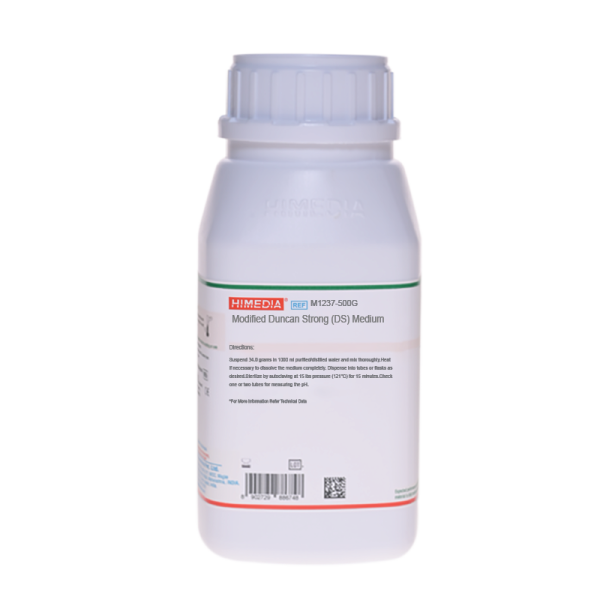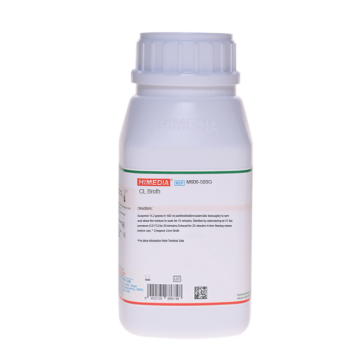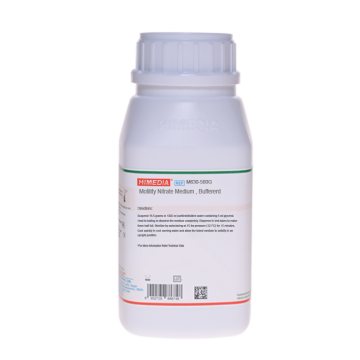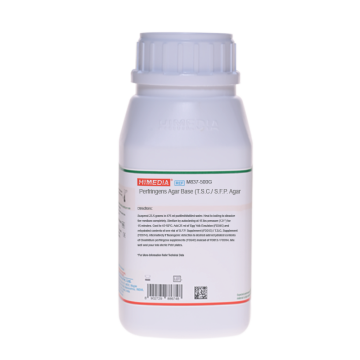 Your enquiry has been submitted
Your enquiry has been submitted
Modified Duncan Strong (DS) Medium
Modified Duncan Strong (DS) Medium is used for isolation and differentiation of Clostridium perfringens from other clostridia from foods on the basis of raffinose fermentation.
Composition**
| Ingredients | Gms/Litre |
|---|---|
| Proteose peptone | 15.000 |
| Yeast extract | 4.000 |
| Sodium thioglycollate | 1.000 |
| Disodium phosphate | 10.000 |
| Raffinose | 4.000 |
Final pH (at 25°C): 7.8±0.2
**Formula adjusted, standardized to suit performance parameters
Directions
Suspend 34 grams in 1000 ml distilled water and mix thoroughly. Heat if necessary to dissolve the medium completely. Sterilize by autoclaving at 15 lbs pressure (121°C) for 15 minutes. Dispense into sterile tubes. Check one or two tubes for measuring the pH.
Principle And Interpretation
Clostridium perfringens, a gram-positive, rod shaped, anaerobic, spore-forming bacteria, is the major cause of food poisoning in humans. A heat labile enterotoxin produced only by sporulating cells induces the major symptoms of diarrhea in perfringens poisoning. C. perfringens is commonly found in raw meats, poultry, dehydrated soups and sauces, raw vegetables and certain other foods or food ingredients.
Modified Duncan Strong (DS) Medium is formulated as per Duncan and Strong (1), and is recommended by APHA (2) for the isolation and differentiation of C. perfringens from other Clostridia from foods on the basis of raffinose fermentation. It is also recommended for the rapid detection of the Clostridium perfringens enterotoxin (3).
Proteose peptone and yeast extract provide nitrogenous compounds and other nutrients for bacterial growth. Sodium thioglycollate helps to create anaerobic conditions suitable for clostridial growth. Disodium phosphate acts as a buffering agent. Raffinose in the medium is fermented by C. perfringens to produce acid within 72 hours, but not by culturally similar species like Clostridium baratii, Clostridium celatum, Clostridium sardiniense etc. To test for acid, transfer 1 ml of culture to a test tube or spot plates and add 2 drops of 0.04% bromothymol blue. A yellow colour indicates acid production.
Inoculate about 2 gm of the food sample into 15-20 ml of Chopped Liver Broth (M606). After an incubation at 35-37°C for 20-24 hours, tubes showing turbidity are streaked on Perfringens Agar Base (M837) containing Egg Yolk Emulsion (FD045) to obtain presumptive C. perfringens. These presumptive colonies can be confirmed by inoculating into Motility Nitrate Medium, Buffered (M630), Lactose Gelatin Medium (M628) and Modified Duncan Strong (DS) Medium (M1237) (2).
Quality Control
Appearance Cream to yellow homogeneous free flowing powder
Colour and Clarity of prepared medium Yellow coloured clear solution without any precipitate
Reaction Reaction of 3.4% w/v aqueous solution at 25°C. pH : 7.8±0.2
pH 7.60-8.00
Cultural Response
M1237: Cultural characteristics observed after an incubation at 35-37°C for 48-72 hours.
| Organism | Inoculum (CFU) | Growth | Raffinose fermentation |
|---|---|---|---|
| Clostridium perfringens ATCC 12924 | 50-100 | good-luxuriant | positive reaction |
| Clostridium sporogenes ATCC 11437 | 50-100 | good-luxuriant | negative reaction |
Storage and Shelf Life
Store below 30°C in tightly closed container and the prepared medium at 2 - 8°C. Use before expiry date on the label.
Reference
- Duncan C. and Strong D., 1969, Appl. Microbiol., 16: 82.
- Labbe R. G. and Rey D. K., 1979, Appl. Microbiol., 13 : 559.
- Downes F. P. and Ito K., (Eds.), 2001, Compendium of Methods for the Microbiological Examination of Foods, 4th Ed., APHA, Washington, D.C.
| Product Name | Modified Duncan Strong (DS) Medium |
|---|---|
| SKU | M1237 |
| Product Type | Regular |
| Physical Form | Powder |
| Origin | Animal |
| Packaging type | HDPE |
| References | 1. Duncan C. and Strong D., 1969, Appl. Microbiol., 16 : 82. |
| Customized Product Available | No |










